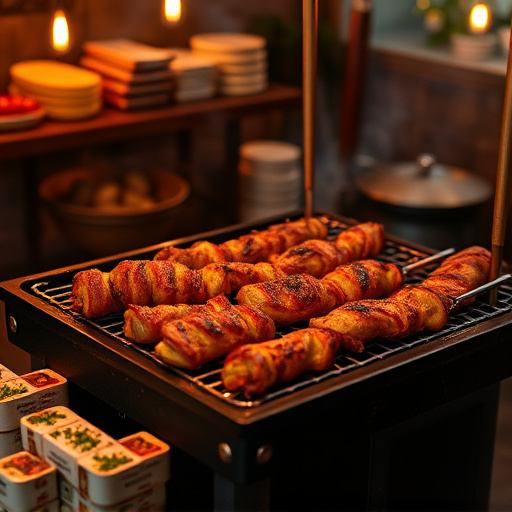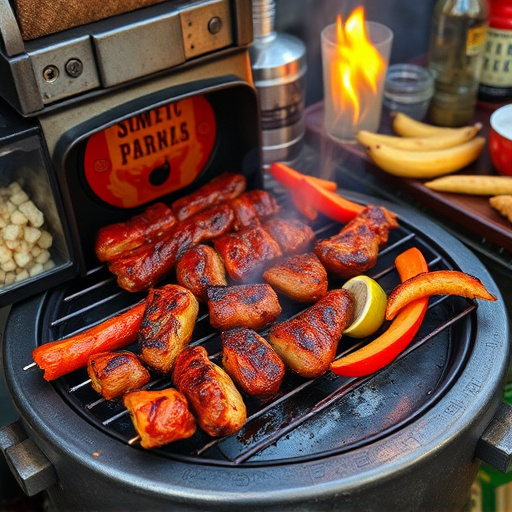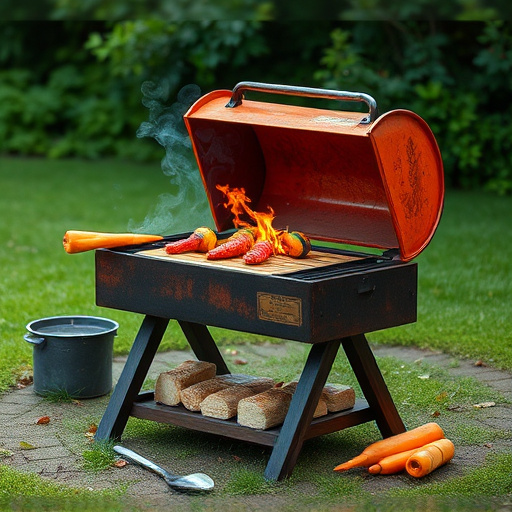Choosing the right beef BBQ rib cut (baby back or spare ribs) is essential for a successful, tender, and flavorful Beef BBQ Ribs Recipe. Trim excess fat and remove membranes, then score the meat for better rub absorption. Bring ribs to room temperature before seasoning and follow these steps for perfect, slow-cooked results.
“Unleash the ultimate comfort food with our guide to crafting the perfect Beef BBQ Ribs Recipe. From selecting the ideal St. Louis-style, baby back, or spare ribs to mastering the art of slow cooking, this journey promises a culinary experience that will tantalize taste buds. Learn the secrets behind creating a homemade spice rub that balances sweet, savory, and heat, then discover the best techniques for smoking or oven roasting your ribs to perfection. Finish with delectable glazing and serving suggestions to elevate your BBQ rib meal.”
- Choosing and Preparing the Ribs
- – Types of beef ribs: St. Louis-style, baby back, or spare ribs
- – Selecting the right cut for slow cooking
- – Tips for trimming and preparing ribs
Choosing and Preparing the Ribs

When it comes to choosing the perfect beef BBQ ribs for your recipe, opt for meaty, well-marbled cuts like baby back or spareribs. Look for a packer cut with a good layer of fat, as this will keep the ribs tender and juicy during the slow cooking process. Before starting your Beef BBQ Ribs Recipe, prepare the ribs by trimming any excess fat (though leave a thin layer for flavor and moisture) and removing the membrane on the bone side. This step ensures that the ribs become fall-off-the-bone tender. Additionally, scoring the meat in a crisscross pattern helps the rub penetrate deeper into the rib, enhancing the overall flavor.
– Types of beef ribs: St. Louis-style, baby back, or spare ribs

Beef BBQ Ribs are a beloved classic in the world of smoking and grilling, offering a tender, juicy experience that meat lovers crave. When it comes to choosing the right ribs for your BBQ Ribs Recipe, there are several styles to consider. The three most popular varieties are St. Louis-style, baby back, and spare ribs, each with its unique characteristics.
St. Louis-style ribs, known for their deep, meaty edges and thin membrane, require a bit more effort to prepare due to the need to remove this membrane for optimal cooking. Baby back ribs, shorter and slightly fatter than their St. Louis counterparts, are often preferred for their tender, succulent meat and are a popular choice for BBQ Ribs Recipes. Spare ribs, the largest and meatiest option, offer a hearty serving of beefy flavor but require careful attention to ensure they don’t become too tough during the cooking process.
– Selecting the right cut for slow cooking

When it comes to slow-cooking juicy beef ribs for a mouthwatering BBQ rib recipe, choosing the right cut is essential. Opt for baby back or spare rib cuts, known for their tenderness and abundant marbling. These cuts are ideal because they contain a good balance of meat and bone, allowing for slow, even cooking and ensuring the ribs remain succulent. The meaty portion provides robust flavour, while the bone adds depth and a satisfying crunch when cooked to perfection.
Selecting the right beef BBQ ribs recipe starts with understanding that slow cooking is a patient process. The cuts mentioned above are designed to break down over time, resulting in incredibly tender ribs that practically fall off the bone. This method allows you to achieve that sought-after, mouthwatering texture and flavour profile that makes homemade beef BBQ ribs so irresistible.
– Tips for trimming and preparing ribs

When preparing beef BBQ ribs for your mouthwatering homemade spice rub recipe, trimming is an essential step that ensures even cooking and a tender final product. Start by removing any excessive fat or membrane attached to the bone side of the ribs. This not only makes your meat more lean but also helps render fats during slow-cooking, adding flavor to your BBQ sauce. Use a sharp knife or a pair of kitchen shears for this task, making sure to cut away any hard, unappealing pieces. After trimming, you can choose to leave the ribs in whole slabs or cut them into smaller segments, depending on your preferred serving style and the number of diners.
For optimal results in your beef BBQ ribs recipe, consider scoring the meat’s surface in a crisscross pattern before applying the spice rub. This simple technique helps the spices penetrate deeper into the meat, enhancing its overall flavor profile. Be careful not to cut too deeply, as you want the layers intact for maximum tenderness. Prepare your ribs at room temperature before seasoning to ensure even absorption of flavors.
